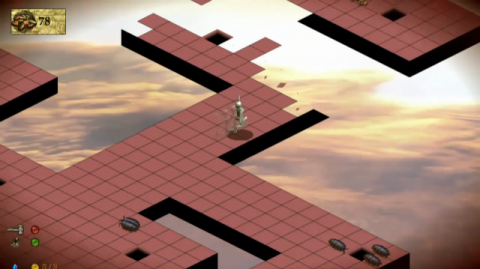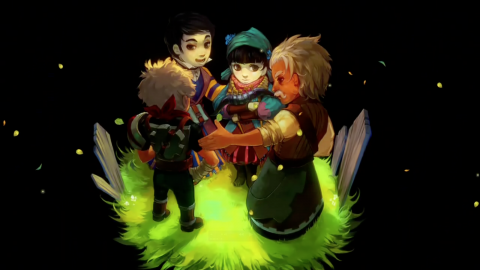Breaking Down the Bastion - A Platform Study
By nkornek 1 Comments
[Reposting For Posterity - I have another, much longer and more in-depth video games paper in the works]
Hey everyone, here's a paper that I wrote for my Videogames as Theory Class. The video series that GiantBomb ran about the development of Bastion was instrumental in helping me write it, so I figured why not share with the GB community. If you guys like this kinda stuff leave some comments and I might post similar papers in the future.
Enjoy!
Breaking Down the Bastion
Storytelling in videogames is often a very linear and directed experience. They frequently rely on cut-scenes, either in real-time or pre-rendered, to break up gameplay sections and convey their narrative to the player. These stories regularly focus on either explaining what the character has just accomplished or providing a set-up for objectives to come. The result is an experience that is heavily guided by the developer, and to the player it can feel entirely scripted like a film. Supergiant Games’ debut title Bastion blends narration with its action and visuals in a way that makes the storytelling feel reactionary rather than pre-defined, and uses these techniques to convey themes of war, racism, and genocide.
Bastion was developed by a small team at Supergiant Games and published by Warner Bros Interactive Entertainment; it was initially released as a downloadable title for Microsoft’s Xbox Live Arcade service in July of 2011. Traditionally, download-only platforms such as Xbox Live Arcade have been chosen by independent developers as a means of distribution because of its low barrier to entry when compared with disc-based products . By capitalizing on a service that caters to shorter, more focused games, developers such as Supergiant are able to produce high-quality products on significantly lower budgets and in much shorter time-frames than their retail-store counterparts. Less than a month after its debut on the Xbox 360, the game was released through Valve Software’s Steam service, and later through Google’s Chrome Web Store. The Steam version differed from the original Xbox version in its inclusion of the turrets from Valve’s Portal series, a form of cross-promotion commonly used as a way of attracting a larger audience to a videogame .
Selecting the Xbox as lead platform allowed the developers to easily port the game to Windows because of the similarities in coding language between the two. The team developed their own editing tools using C-sharp in order to accomplish many of the unique aspects of the game, and thus were able to easily tweak their engine whenever necessary . The game’s visuals evolved significantly throughout the development process, beginning with basic shapes and monsters scanned out of Dungeons and Dragons manuals and eventually evolving to whimsical hand-painted art. The distinctive mechanic of having the world form under the player’s feet was present from the very beginning of development, and posed a challenge to the designers who needed to ensure that players could both easily determine their orientation without seeing the entire path ahead as well as be unable to outrun the world as it forms .

Bastion borrows many of its gameplay mechanics from older games such as the Super Nintendo era Legend of Zelda titles as well as Square’s Secret of Mana. The camera operates solely from an isometric perspective and the action is fairly simple. Several gaming conventions appear, such as basic controls as well as some traditional weapons like the hammer, bow, and shield. These practices allow many new players to be immediately familiar with aspects of the game as soon as they begin their play. There are also many aspects of the game that were implemented to comply with Microsoft’s certification process, for example the text that appears during loading screens and the quickness of the game’s introduction.
The game interfaces with its players primarily through audio and video. Contrary to most other videogames which are completely static, these two layers react directly to the player’s actions. With Bastion, what the player inputs on their controller is reflected in the game with much more than just player movement. The geometry of the levels forms in the player’s path as they move through each level, making the world much more dynamic, even if the paths themselves were pre-defined by the developers. By tying the creation of the world to the player’s actions, it ensures that no part of the world is a static place; instead each tile that rises to form the ground becomes part of the game’s space. The world itself becomes an active part of the game, rather than a simple backdrop for the action. The most dynamic aspect of Bastion is the reactive narration. The game will frequently select differed pieces of dialogue based on the player’s actions and the different ways that they may vary. When describing the narrator, writer Greg Kasavin elaborated that “We want him to respond to what you are doing rather than just talk all the time” . For example, when fleeing from destruction a player who frequently uses the roll maneuver to move quickly will hear the narrator comment on how he is “somersaulting like crazy”. The designers filled their game with these individual audio comments that not every player may hear. The technique of observing and directly responding to an audience’s actions is a type of focalization that is normally impossible in other forms of media such as film, and it works to better incorporate that audience in the story.

The emotional investment that Bastion gets from players through its reactive visuals and narration allows its story to have a much greater impact. The events of the game deal with important social issues such as war, racism and genocide. While these central themes pervade the storyline, none of them actually have a significant impact on gameplay; the player has no incentive to side with any particular opinion other than their personal moral compass. Films have often tackled these very same issues, but the nature of the medium always leaves the audience detached from the true experience. By giving the player choices related to these issues and using reactive narration to better convey the impact of those choices, Bastion can make the player feel the weight of its message and better understand its characters’ motivations. In addition to the impact on story, the game’s use of visuals also leads to different player experiences. Because the ground only forms in areas that the player is exploring, levels often feature secret areas that not all players may locate. Habitually these areas contain additional pieces of backstory that lend their gravitas to the world, and further separate each individual player’s experience with the game.
To conclude, Bastion differentiates itself through its unique reactionary mechanics. The developers both designed their own tools and played to the pre-existing strengths of their platforms to achieve the game’s goal of being a dynamic experience. Both its audio and its video aspects are intelligently used to emotionally connect players to the game’s narrative, and thus convey a story by integrating the player’s own morals and the choices that they make. Bastion applies the strengths of gaming interactivity by engaging players and delivering its message in a way that would not be possible in static mediums such as film.
